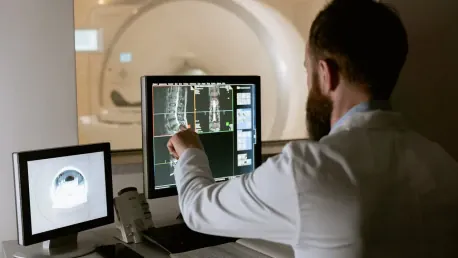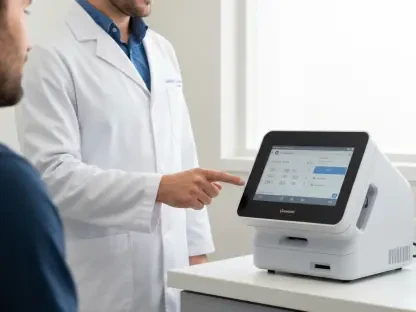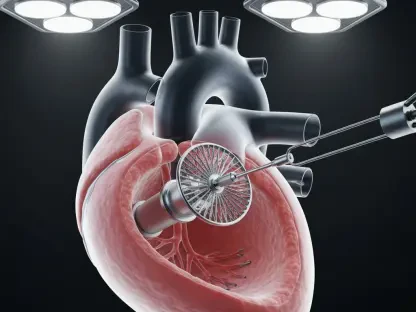The development of a new handheld photoacoustic tomography (PAT) scanner by researchers at University College London (UCL) marks a groundbreaking advancement in medical imaging technology. Initially developed in 2000, PAT technology utilizes the photoacoustic effect, wherein laser-generated ultrasound waves visualize subtle changes in human veins and arteries. This technology holds immense potential in identifying early markers of diseases like cancer by visualizing changes in minute blood vessels situated up to 15mm deep in tissues. However, conventional PAT scanners have been handicapped by slow image acquisition times and the necessity for patient immobility during scanning.
Overcoming Traditional Limitations
Slow Image Acquisition and Motion-Induced Blurring
Traditional PAT scanners produce 3D images by measuring ultrasound waves at multiple distinct points sequentially over the tissue surface, making the imaging process excessively slow and prone to motion-induced blurring. Conventional scanners’ image capture method significantly slows down the process, leading to challenges in clinical settings where even slight patient movements can render the images clinically unusable. These limitations have impeded the widespread adoption of this promising technology, despite its potential to offer invaluable insights into the human body’s vascular changes.
Despite these limitations, the new PAT technology in development by UCL researchers seeks to revolutionize this sphere by drastically shortening the time required to capture high-quality 3D images, significantly reducing it from over five minutes to just a few seconds or less. This impressive reduction in image acquisition time is a game-changer, allowing for swift and accurate imaging that can be conducted with minimal patient discomfort and eliminating the issue of motion-induced blurring. By addressing these key challenges, the new handheld PAT scanner promises to unlock the technology’s full clinical potential.
Technical Advancements in PAT Technology
This expedited imaging process is achieved through two main technical advancements. First, the scanner design has been updated to detect ultrasound waves at multiple points simultaneously, fundamentally reducing image acquisition time. This innovation in sensor design allows for a rapid capture of high-quality images without the need for sequential measurements, transforming the PAT scanning experience. By capturing ultrasound data more efficiently, the new scanner opens the door to real-time imaging capabilities, which are crucial for dynamic physiological monitoring.
Second, the UCL research team has incorporated advanced mathematical principles akin to those used in digital image compression. This refinement enables the reconstruction of high-quality images from fewer measurements of the ultrasound waves, further accelerating the image acquisition pace. The integration of these advanced computational techniques not only boosts the scanning speed but also improves the overall image quality, ensuring that clinicians receive clear and detailed visual data. Together, these technical advancements represent a significant leap forward in the practical application of PAT technology.
Clinical Applications and Pre-Clinical Tests
Testing on Various Conditions
The UCL team has demonstrated the utility of their handheld PAT scanner through pre-clinical tests involving patients with type-2 diabetes, rheumatoid arthritis, and breast cancer, as well as healthy volunteers. These trials showcased the scanner’s ability to produce detailed 3D images of the microvasculature, offering a non-invasive means to observe vascular changes that traditional imaging techniques often miss. Notably, the scanner was able to highlight deformities and structural changes in the blood vessels of diabetic patients’ feet, providing vital information for early diagnosis and management.
In addition to diabetes-related applications, the new PAT scanner proved useful in visualizing skin inflammation associated with breast cancer. The ability to see detailed images of vascular changes linked to various conditions marks a significant improvement over traditional scanners. By demonstrating the handheld scanner’s effectiveness across different patient groups and conditions, the UCL team has laid a strong foundation for the device’s potential clinical applications. The insights gained from these pre-clinical tests hint at a future where PAT imaging can become a staple in routine medical diagnostics.
Potential for Early Disease Detection
For conditions like peripheral vascular disease (PVD), a complication commonly seen among diabetic patients, early identification of changes in tiny blood vessels can be critical. The ability to detect microvascular changes early on can be the difference between successful intervention and irreversible tissue damage. Existing imaging techniques, such as MRI, often fail to detect these early changes, highlighting the need for more sensitive methods. PAT imaging, with its potential to visualize these changes in great detail, offers a groundbreaking approach that could transform how clinicians identify and address the onset of PVD.
The capability to see the increased density of small blood vessels linked to tumors could significantly aid in cancer detection and treatment planning. As tumors develop, they often stimulate the formation of new blood vessels, a process known as angiogenesis. By visualizing this increased vascularity, PAT imaging provides crucial information that can influence treatment decisions. It can help in distinguishing between benign and malignant growths and assist in planning surgical interventions with greater precision. This potential to enhance early disease detection underscores the scanner’s promise as a revolutionary tool in modern medicine.
Technological and Clinical Advantages
Overcoming Piezoelectric Sensor Limitations
Dr. Nam Trung Huynh, a senior research fellow at UCL, discussed the limitations of traditional piezoelectric sensor technology, often used in existing scanner technology. These sensors, while effective, can restrict the amount of image information captured and are not always convenient for general clinical practice. Their dependence on operator skill and the inherent limitations in capturing detailed 3D images have long plagued the field of medical imaging. The traditional 2D imaging systems that rely on piezoelectric sensors often fall short in providing comprehensive views of complex anatomical structures.
The new PAT scanner overcomes these limitations by offering full 3D imaging capabilities. This advancement eliminates operator dependence, ensuring consistent and objective volumetric views of the scanned areas. The transition to 3D imaging not only enhances the level of detail available to clinicians but also reduces the risk of misinterpretation caused by subjective factors. By addressing the shortcomings of piezoelectric sensor technology, the new scanner sets a new standard for image quality and reliability in medical diagnostics, making it a more viable option for widespread clinical use.
Real-Time Imaging and Dynamic Visualization
Professor Paul Beard, leading the study, underscored the importance of the rapid image acquisition enabled by their new technology. The increased speed avoids motion-induced blurring and yields highly detailed, quality images unseen in other scanners. This ability to quickly capture high-resolution images transforms the scanning process, making it more efficient and patient-friendly. The real-time imaging capability allows for an instant assessment of physiological changes, providing immediate feedback that can be crucial during clinical evaluations.
Furthermore, the ability to capture real-time images allows visualization of dynamic physiological events, thus enabling new insights into human biology and disease progression. The scanner’s ability to monitor these events live opens up new avenues for research and diagnostics. It can track changes in blood flow, observe inflammation responses, and provide a detailed view of how diseases develop and evolve over time. This dynamic visualization capability represents a significant leap forward, offering a deeper understanding of various medical conditions and enhancing the ability to tailor treatments to individual patient needs.
Future Prospects and Development
Need for Further Testing and Validation
The pilot study results with the handheld scanner were promising, suggesting potential as a game-changer for medical practice and understanding. Researchers highlighted the impressive performance of the scanner in early trials, but they also acknowledged the necessity for further extensive testing and validation of their findings. The initial success needs to be corroborated with larger patient cohorts to ensure the scanner’s efficacy and reliability across diverse demographics and conditions. Comprehensive clinical trials are essential to fully establish the scanner’s role in modern diagnostics.
Additionally, they emphasized the need to refine the scanner for use by medical personnel and ensure the extraction of valuable clinical information. This involves making the technology more user-friendly, ensuring that it can be operated efficiently in various clinical settings. Training programs and user manuals will be crucial in achieving this goal. Refining the scanner’s software and interface to streamline data analysis will also play a pivotal role in its adoption. The aim is to create a device that provides clear, actionable insights that can easily be integrated into routine medical practice.
Collaboration and Regulatory Approval
Researchers at University College London (UCL) have developed an innovative handheld photoacoustic tomography (PAT) scanner, marking a significant leap in medical imaging technology. PAT, initially introduced in 2000, leverages the photoacoustic effect, which uses laser-generated ultrasound waves to visualize minute changes in blood vessels, both veins and arteries. This advanced imaging technology is particularly promising for early disease detection, such as identifying initial indicators of cancer by observing alterations in tiny blood vessels located up to 15mm beneath the skin. Despite its potential, traditional PAT scanners have faced limitations, notably slow image acquisition times and the requirement for patients to remain completely still during the scanning process, which can be impractical in clinical settings. The new handheld design aims to overcome these limitations, ensuring faster, more efficient imaging while offering greater flexibility and comfort for patients. This breakthrough could thus facilitate early diagnosis and treatment, significantly improving patient outcomes.









